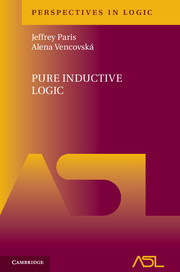Book contents
- Frontmatter
- Contents
- PREFACE
- Part 1 The Basics
- Part 2 Unary Pure Inductive Logic
- Chapter 8 Introduction to Unary Pure Inductive Logic
- Chapter 9 De Finetti's Representation Theorem
- Chapter 10 Regularity and Universal Certainty
- Chapter 11 Relevance
- Chapter 12 Asymptotic Conditional Probabilities
- Chapter 13 The Conditionalization Theorem
- Chapter 14 Atom Exchangeability
- Chapter 15 Reichenbach's Axiom
- Chapter 16 Carnap's Continuum of Inductive Methods
- Chapter 17 Irrelevance
- Chapter 18 Another Continuum of Inductive Methods
- Chapter 19 The NP-Continuum
- Chapter 20 The Weak Irrelevance Principle
- Chapter 21 Equalities and Inequalities
- Chapter 22 Principles of Analogy
- Chapter 23 Unary Symmetry
- Part 3 Polyadic Pure Inductive Logic
- BIBLIOGRAPHY
- Index
- Symbols and Abbreviations
Chapter 8 - Introduction to Unary Pure Inductive Logic
from Part 2 - Unary Pure Inductive Logic
Published online by Cambridge University Press: 05 May 2015
- Frontmatter
- Contents
- PREFACE
- Part 1 The Basics
- Part 2 Unary Pure Inductive Logic
- Chapter 8 Introduction to Unary Pure Inductive Logic
- Chapter 9 De Finetti's Representation Theorem
- Chapter 10 Regularity and Universal Certainty
- Chapter 11 Relevance
- Chapter 12 Asymptotic Conditional Probabilities
- Chapter 13 The Conditionalization Theorem
- Chapter 14 Atom Exchangeability
- Chapter 15 Reichenbach's Axiom
- Chapter 16 Carnap's Continuum of Inductive Methods
- Chapter 17 Irrelevance
- Chapter 18 Another Continuum of Inductive Methods
- Chapter 19 The NP-Continuum
- Chapter 20 The Weak Irrelevance Principle
- Chapter 21 Equalities and Inequalities
- Chapter 22 Principles of Analogy
- Chapter 23 Unary Symmetry
- Part 3 Polyadic Pure Inductive Logic
- BIBLIOGRAPHY
- Index
- Symbols and Abbreviations
Summary
In the initial investigations of Johnson and Carnap the language was taken to be unary. That is, in the notation we are adopting here the relation symbols R1, R2, …, Rq of the language L all had arity 1, and so would more commonly be referred to as ‘predicate’ symbols. Carnap, [12, p123–4], and later Kemeny [64, p733–4], did comment that generalizing to polyadic relations was a future goal but with a few isolated exceptions there was almost no movement in that direction for the next 60–70 years.
There seem to be at least three reasons for this. Firstly the subject, and particularly the notation, becomes much more involved when we introduce non-unary relation symbols, a point which Kemeny acknowledged in [64] (appearing in 1963 though actually written in 1954). Secondly one's intuitions about what comprises rationality appear less well developed with regard to binary, ternary, etc. relations, possibly because in the real world they are not so often encountered, so the need to capture those fainter whispers which do exist seems less immediately pressing. Thirdly, for those working in the area there were more than enough issues to be resolved within the purely unary Pure Inductive Logic.
For all of these reasons it seems quite natural to concentrate first on the unary case. In addition many of the notions that this will lead us to study will reappear later in the polyadic case where this prior familiarity, in a relatively simple context, will provide an easy introduction and stepping stone to what will follow.
Our method in this, and the next chapter, will be to introduce various principles that one might argue our agent should observe on the grounds of their perceived rationality, though we will not set very high demands on what this amounts to. It will be enough that one is willing to entertain the idea that these principles are somehow rational. As already indicated these principles will largely arise from considerations of symmetry, relevance and irrelevance.
- Type
- Chapter
- Information
- Pure Inductive Logic , pp. 49 - 54Publisher: Cambridge University PressPrint publication year: 2015



